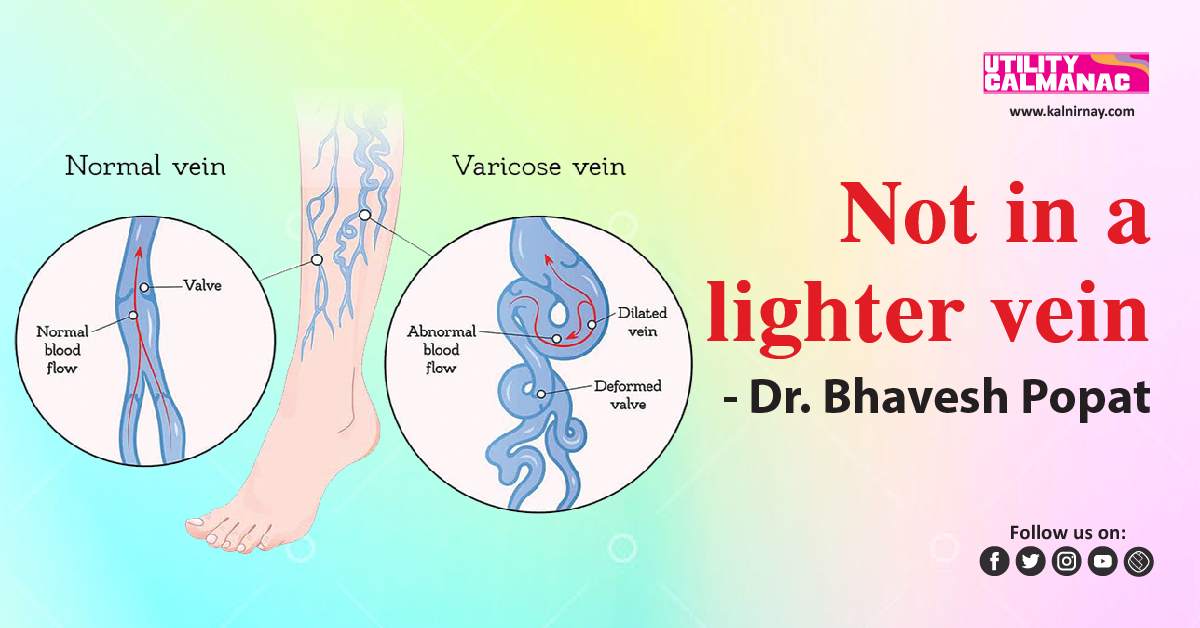Not in a lighter vein
Varicose veins is a seemingly minor, yet potentially fatal condition.
When it comes to health, we always watch out for an illness that may immediately kill us. In the bargain, little or no effort is made to identify and control health conditions which may take a serious form over years. Varicose veins can seriously affect the quality of life initially and may progress into fatal conditions. If identified and treated early, it can be cured quite effectively.
What are Varicose veins?
Veins are blood vessels that transport blood from various body parts to the heart for re-circulation. The varicose vein is a clinical condition in which the normal veins do not function the way they are supposed to. Arteries carry oxygenated (pure) blood from the heart to various parts of our body with pressure. Veins transport used-up (impure) blood back to the heart. On this return journey, most of the pressure from the pumping heart is lost and veins don’t get the support they need to keep pushing this blood back. To overcome the reduced pressure, veins are equipped with tiny valves that open and shut to help regulate the blood flow back to the heart.
At times, these tiny valves begin to malfunction, allowing blood to back up and “pool” behind the valves. Over time, the vein walls become weak and veins begin to bulge, causing raised, welt (swollen vein) like appearance we see as Varicose veins. Spider veins are similar but smaller. Varicose veins are normally swollen and enlarged. They often are lumpy, bulging or twisted and sometimes may be red, blue/purple.
To understand this better, imagine when a traffic light that controls the movement of traffic in one direction breaks down creating a traffic jam. Similarly, when the valves in the veins do not work properly, blood movement is obstructed which may result in Varicose veins.
What causes Varicose veins?
Various factors may trigger the onset of venous issues, like obesity, age, working conditions, smoking, oral contraceptives, etc. Genetics also play a major role in the development of this condition. It is observed that this condition affects women more than it affects men.
Factors which put you at risk for Varicose veins :
- Professions or occupations which require you to be on your feet like teachers, stewards, chefs, doctors, nurses, guards etc.
- Obese individuals are more likely to develop a vein problem.
- Pregnancy, puberty and menopause cause hormonal changes. These may influence the occurrence of Varicose veins. Post-menopausal hormone replacement therapy and the use of oral contraceptive pills also have been considered risk factors.
- Genetics are known to play a role in the onset of vascular conditions and Varicose veins are no exception.
- History of blood clots.
- Conditions that create more than normal pressure in the abdomen such as constipation, tumours, garments like girdles or corsets etc.
- Research has identified some other causes like injury/trauma to the skin, history of vein surgery and ultraviolet rays exposure.
While Varicose veins may themselves not be a critical condition, ignoring them may cause serious medical issues that adversely affect the quality of life. An early diagnosis will lead to early relief from symptoms and curb the condition from worsening. If left untreated, Varicose veins increase the chances of developing painful ulcers and a potentially fatal condition called deep vein thrombosis (DVT). If you experience any or a combination of the symptoms listed below, you must seek a doctor’s help:
- Heavy, uncomfortable and aching legs.
- Mild to heavy swelling.
- Throbbing and burning sensation in legs.
- Muscle cramps in legs.
- Dryness and itchiness over the vein.
- Slow healing sores, dark patches.
- Thickening of skin around calves or ankles.
If you have any of the above symptoms, the first step is to meet an interventional radiologist who will assess your condition and suggest treatment. If the condition is identified at an early stage, the treatment can be as simple as medication and the use of stockings. However, in situations where the disease has progressed, some advanced treatment options like endo-venous laser ablation or VenaSeal might be recommended based on every individual’s unique assessment.
How to avoid Varicose veins:
- Exercise regularly. Control weight.
- Elevate legs whenever possible.
- Eat a balanced diet, preferably low in salt and high in fibre.
- Avoid high heels and tight constricting clothing.
- Moving around between long periods of standing or sitting.
To read more English blogs, visit our blog section.
Dr Bhavesh Arun Popat
The author is an experienced interventional radiologist.

